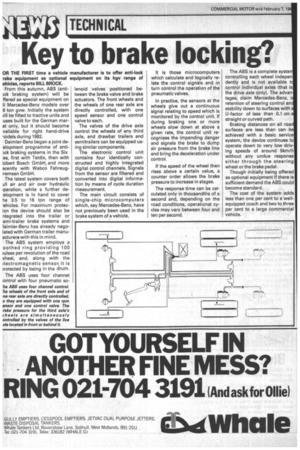Key to brake lockin gi
Page 22

If you've noticed an error in this article please click here to report it so we can fix it.
OR THE FIRST time a vehicle rake equipment as optional ehicles, reports BILL BROCK. From this autumn, ABS (anti)ck braking system) will be ffered as special equipment on II Mercedes-Benz models over 6 ton gvvv. Initially the system rill be fitted to tractive units and uses built for the German maret only, but it should become vailable for right hand-drive iodels during 1982.
Daimler-Benz began a joint deelopment programme of anti)ck braking systems in the Six es, first with Teldix, then with Iobert Bosch GmbH, and more ecently with Wabco Fahreugiremsen GmbH.
The latest system covers both J II air and air over hydraulic iperation, while a further deelopment is in hand to cover he 3.5 to 16 ton range of 'ehicles. For maximum protecion the device should also be Ttegrated into the trailer or emi-trailer brake systems and )aimler-Benz has already negoiated with German trailer menuacturers with this in mind.
The ABS system employs a oothed ring providing 100 )ulses per revolution of the road vheel, and, along with the :lectromagnetic sensor, it is )rotected by being in the drum.
The ABS uses four channel :ontrol with four pneumatic so
he ABS uses four channel control. he wheels of the front axle and of ne rear axle are directly controlled, o they are equipped with one rpm ensor and one control valve. The rake pressure for the third axle's vheels are simultaneously ontrolled by the valves of the live xle located in front or behind it.
lenoid valves positioned between the brake valve and brake actuators. The front wheels and the wheels of one rear axle are directly controlled, with one speed sensor and one control valve to each.
The valves of the drive axle control the wheels of any third axle, and drawbar trailers and semitrailers can be equipped using similar components.
The electronic control unit contains four identically constructed and highly integrated digital control channels. Signals from the sensor are filtered and converted into digital information by means of cycle duration measurement.
The main circuit consists of single-chip microcomputers which, say Mercedes-Benz, have not previously been used in the brake system of a vehicle, It is those microcomputers which calculate and logically relate the control signals and in turn control the operation of the pneumatic valves.
In practice, the sensors at the wheels give out a continuous signal relating to speed which is monitored by the control unit. If during braking one or more wheels slow down at above a given rate, the control unit recognises the impending danger and signals the brake to dump air pressure from the brake line and bring the deceleration under control.
If the speed of the wheel then rises above a certain value, a counter order allows the brake pressure to increase in stages.
The response time can be calculated only in thousandths of a second and, depending on the road conditions, operational cycles may vary between four and ten per second. The ABS is a complete syste controlling each wheel indepen dently and is not available t control individual axles (that is the drive axle only). The advan tages, claim Mercedes-Benz, 1 retention of steering control an stability down to surfaces with U-factor of less than 0.1 on straight or curved path.
Braking distances on all road surfaces are less than can be achieved with a basic service system, the device continues to operate down to very low driving speeds of around 5km/h without any undue response either through the steering wheel or the brake pedal.
Though initially being offered as optional equipment if there is sufficient demand the ABS could become standard.
The cost of the system adds less than one per cent to a wellequipped coach and two to three per cent to a large commercial vehicle.












































































































